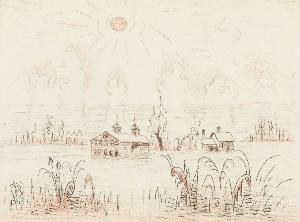Charles Ephraim Burchfield
Charles Burchfield;Charles Ephraim Burchfield
מקום: Ashtabula
נוֹלָד: 1893
מָוֶת: 1967
בִּיוֹגְרַפִיָה:
Early Life and Education
Charles Ephraim Burchfield, an American painter and visionary artist, was born on April 9, 1893, in Ashtabula, Ohio. He was raised by his widowed mother in Salem, Ohio, where he spent most of his early years. Burchfield's artistic journey began at the Cleveland Institute of Art, which he attended from 1916.
Artistic Style and Influences
Burchfield's work is characterized by passionate watercolors of nature scenes and townscapes. His unique style, often described as a blend of visionary and transcendental, was influenced by various English writers, including Thoreau and Willa Cather. Additionally, Burchfield's exposure to modernist European trends and traditional Chinese painting during his time at the Cleveland Institute of Art significantly shaped his artistic approach.
Notable Works and Periods
* Charles Ephraim Burchfield's work can be divided into three periods:
- Figuration, houses, and small town scenes
- Abstractions depicting moods (frequently morbid and fearful)
- Large, hallucinatory renditions of nature captured in swirling strokes, heightened colors, and exaggerated forms
Some notable works include: * Parc Monceau, Paris by Frederick Childe Hassam, which showcases Burchfield's influence on other artists. * Mrs. Frederick Roller by John Singer Sargent, an example of Burchfield's middle period. * Dutch Farmhouse with Woman by Max Liebermann, reflecting Burchfield's late period.
Museums and Legacy
Burchfield's work is featured in various prominent museums, including the Tunbridge Wells Museum and Art Gallery (Royal Tunbridge Wells, United Kingdom) and the Frye Art Museum (Seattle, Washington). The Charles Burchfield Center at Buffalo State College was dedicated in his honor in 1966, later renamed the Burchfield-Penney Art Center. View more works by Charles Ephraim Burchfield on Wikioo.org














